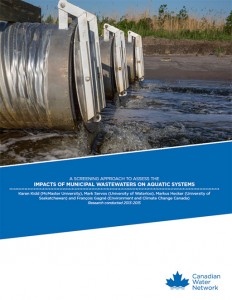Aquatic Impact Assessment of Municipal Effluents
Markus Hecker, University of Saskatchewan (2013-2015)

Challenge
During conventional wastewater treatment, the elimination of pharmaceuticals and personal care products, as well as natural hormones and other contaminants is often incomplete and inefficient. Municipal wastewater effluent may contain chemicals which have disruptive impacts on the endocrine system of aquatic organisms. The endocrine system is a collection of glands that produce hormones to regulate metabolism, growth, sexual function, development and reproduction, among other things.
In recent decades, national and international governments have established approaches and regulatory frameworks to assess the risks posed by endocrine-disrupting chemicals (EDCs). Despite Canada’s efforts towards establishing standard test strategies and decision-making criteria for monitoring and assessing sources of EDCs to the environment, effluent from wastewater treatment plants (WWTPs) have remained one of most predominant sources.
Project
This project used a set of techniques (a toolbox) to characterize and assess the potential effects of municipal wastewater effluent and its possible impacts on downstream aquatic organisms. Two sites in Saskatchewan were investigated: Wascana Creek, downstream of the Regina WWTP, and the Saskatchewan River, downstream of the Saskatoon WWTP. Reference sites were also selected upstream of the exposure locations.
Both locations were investigated using similar approaches, separated into three parallel tiers. In the first tier, effluents or downstream waters were screened for toxicity using a suite of tests that will examine cell toxicity, as well as disruption of estrogen, testosterone or steroid hormone production.
- Effect directed analysis, which is an approach that focuses on the identification and assessment of toxicants on the basis of adverse effects and exposure, allowed the researchers to observe the effects in fish.
- Biological activity in one or more of the tests triggered a second tier of testing that considered the reproductive success of the test fish species.
- A parallel laboratory experiment was conducted at the University of Lethbridge to chemically characterize EDCs responsible for producing the biological effects seen in the first phase of testing.
Outputs
- This project developed, evaluated and validated a tiered screening approach using predetermined techniques and tools that will enable efficient, economical and relevant assessment of the toxicological risks of municipal wastewater effluents.
- A final project symposium was held with all project partners and advisors to synthesize a feasible screening approach for potential future testing requirements.
- Presentations were conducted at national or international conferences such as the Aquatic Toxicity Workshop and Society for Environmental Toxicology and Chemistry (SETAC) meetings.
- Members of the research team contributed to publications in leading, high impact, peer-reviewed publications.
Outcomes
- Knowledge generated regarding the risks that various wastewater treatment options pose on aquatic ecosystems have been used to inform and support decision making and practice.
- Cost savings can be realized by minimizing the number of tests required and maximizing the identification of potential adverse effects.
- Despite a regional focus in Saskatchewan, the project had outcomes that are applicable to wastewater treatment plants and receiving water bodies across the country.





